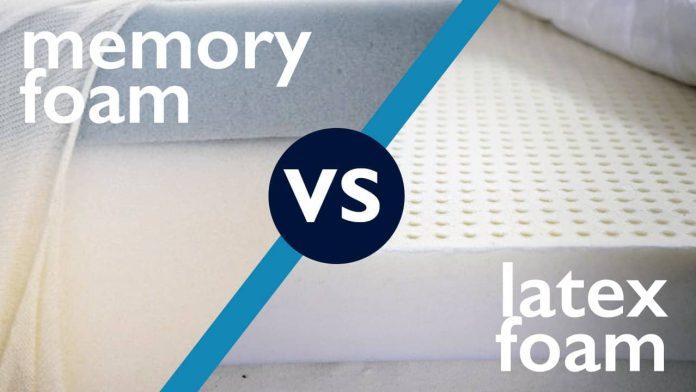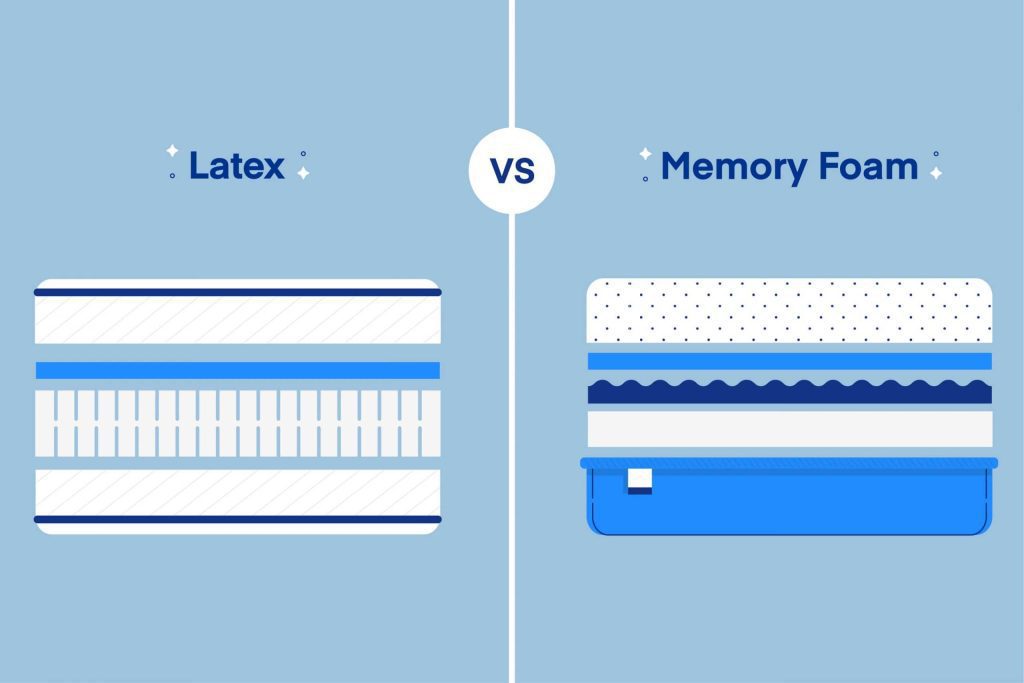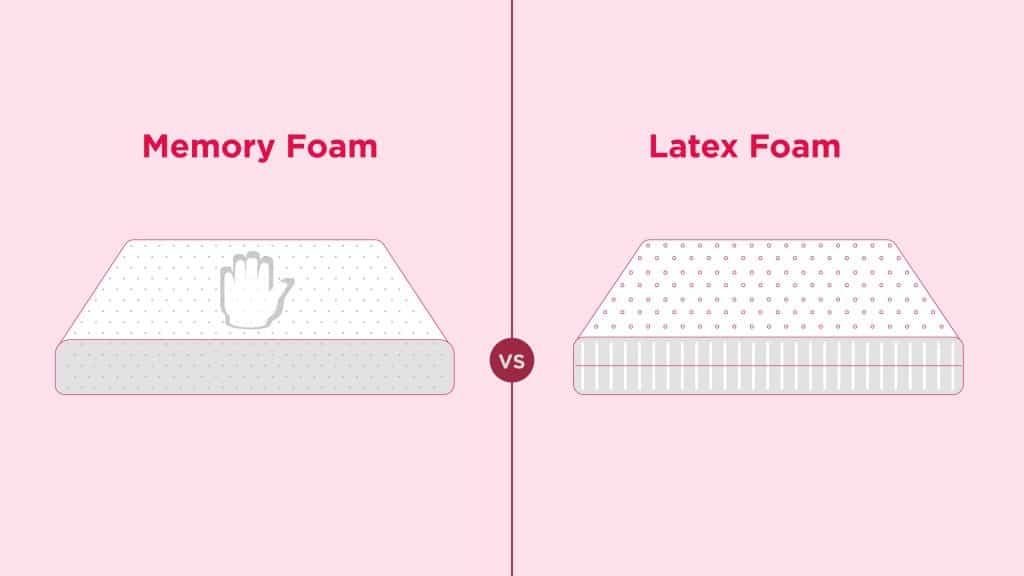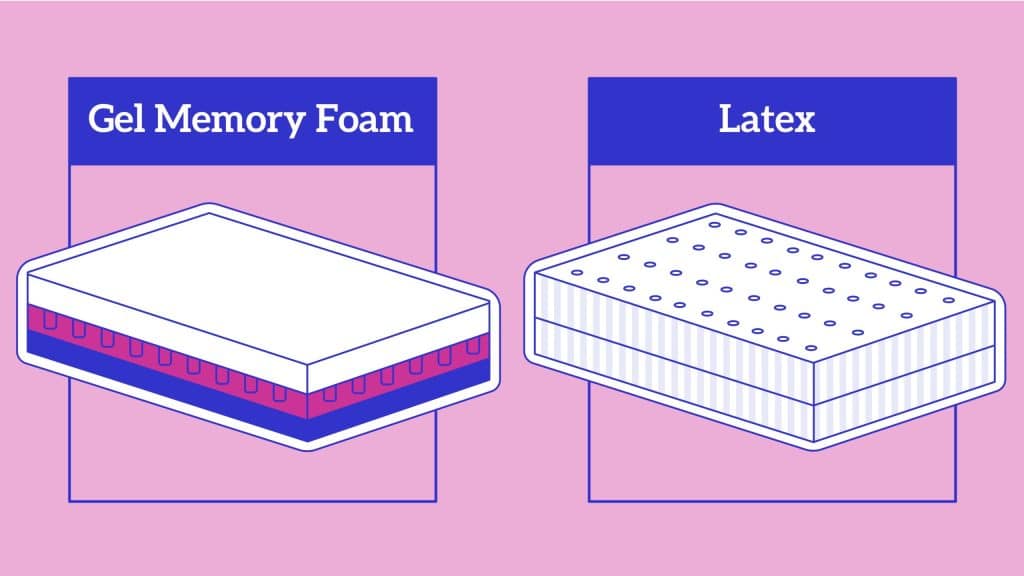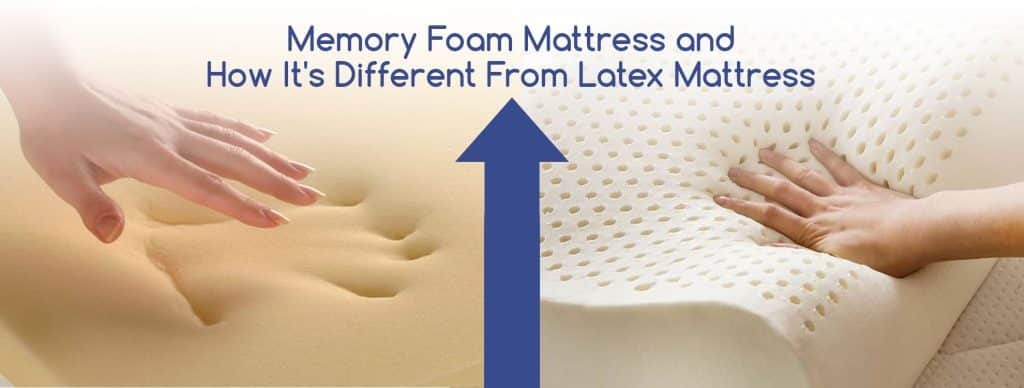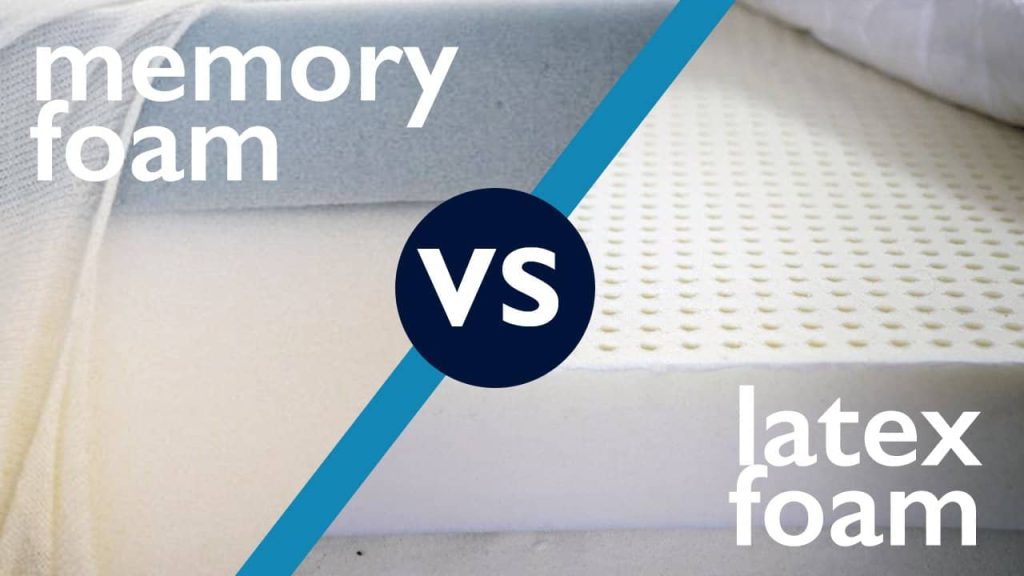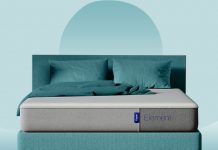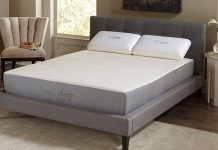Are you curious about the contrast between memory foam and latex mattresses? Well, look no further! We’re here to shed some light on this often-debated topic.
From their composition and comfort levels to their durability and eco-friendliness, we’ll break down all the critical dissimilarities between these two popular mattress materials.
So, please sit back, relax, and let us help you make an informed decision when choosing the mattress of your dreams.
Review contents
Density
Memory Foam Density
Regarding density, memory foam is known for its ability to provide excellent support and pressure relief. Memory foam density is measured in pounds per cubic foot (PCF). The higher the density, the firmer and more durable the mattress. Memory foam mattresses typically range from 2.5 PCF to 7.0 PCF.
A higher-density memory foam mattress will offer better support and longevity. It will also be less likely to develop sagging or indentations over time. On the other hand, a lower-density memory foam mattress may be softer and provide a plush feel, but it may not last as long and may lose its supportive properties sooner.
Latex Density
Latex mattresses also come in different densities, typically measured by the unit of ILD (Indentation Load Deflection). The ILD rating indicates how firm or soft the latex foam is. The higher the ILD, the firmer the mattress will be. Latex mattresses can range from 15 ILD to 50 ILD or more.
A higher-density latex mattress will provide firmer support and durability. It will also be more resilient and resistant to compression, making it less likely to develop permanent body impressions. However, a lower-density latex mattress will offer a softer feel and may be more suitable for individuals who prefer a plush sleeping surface.
Support
Memory Foam Support
Memory foam mattresses are renowned for their ability to provide exceptional support. The contouring properties of memory foam allow it to conform to your body’s shape, providing targeted support to your pressure points and aligning your spine correctly. This can help relieve pain and promote better spinal alignment during sleep.
Memory foam mattresses offer even support across your body, regardless of your sleeping position. This is particularly beneficial for individuals with back or joint pain, as it reduces the pressure on sensitive areas and allows for proper weight distribution.
Latex Support
Latex mattresses also offer excellent support. The natural elasticity of latex allows it to conform to your body’s contours, providing optimal support and pressure relief. Latex mattresses are known for their ability to promote proper spinal alignment, which can alleviate back or neck pain.
Latex mattresses are also highly responsive and can adapt quickly to your movements at night. This responsiveness helps prevent the feeling of sinking too deeply into the mattress and provides a supportive sleep surface.
This image is the property of amerisleep.com.
Conforming Ability
Memory Foam Conforming Ability
Memory foam is renowned for its exceptional conforming ability. When you lie down on a memory foam mattress, it responds to your body heat and weight, softening and molding to your unique contours. This creates a personalized and supportive sleep surface, eliminating pressure points and promoting proper spinal alignment.
The conforming ability of memory foam allows it to distribute your body weight evenly, improving blood circulation and reducing the likelihood of tossing and turning during the night. It can also help relieve pain and discomfort, making it a suitable choice for individuals with chronic pain conditions or those recovering from injuries.
Latex Conforming Ability
While latex mattresses offer some degree of conforming ability, they do not contour to your body in the same way as memory foam. Latex mattresses are more responsive and bouncy, providing support and buoyancy.
Latex foam is designed to provide pressure relief and support but has a natural resilience that allows it to regain its original shape quickly. This responsive nature of latex provides a more “on top” feel rather than a deep sinking sensation, making it suitable for individuals who prefer a more resilient sleeping surface.
Durability
Memory Foam Durability
Memory foam mattresses are known for their durability. High-density memory foam mattresses are more durable and can last 10-15 years or longer with proper care. The density of memory foam helps it retain its shape and support over time, reducing the likelihood of sagging or permanent indentations.
Memory foam mattresses with lower densities may still offer decent durability, but they may be more prone to wearing out faster and losing their supportive properties. It is essential to consider the density of the memory foam when evaluating its durability.
Latex Durability
Latex mattresses are also known for their durability. Natural latex, in particular, is resilient and can withstand years of use without significant deterioration. Latex mattresses can last 10-15 years or more, depending on the quality and care provided.
Latex foam is resistant to compression, meaning it can bounce back to its original shape even after extended periods of use. This resilience makes latex mattresses highly durable and prevents the development of body impressions or sagging.
This image is the property of zomasleep.com.
Heat Retention
Memory Foam Heat Retention
One of the potential drawbacks of memory foam mattresses is their tendency to retain heat. Memory foam is known for its ability to contour your body but also tends to trap body heat, leading to a warmer sleeping surface.
However, advancements in memory foam technology have led to the development of cooling gel-infused memory foam, which helps dissipate heat and regulate body temperature during sleep. Some memory foam mattresses also feature open-cell foam structures or ventilation channels that promote airflow and minimize heat retention.
Latex Heat Retention
Latex mattresses have a more breathable nature compared to memory foam. The open-cell structure of latex foam allows for better air circulation, keeping the mattress cooler and preventing heat buildup. Latex mattresses are generally considered more temperature-neutral and suitable for sleeping hot individuals.
Latex mattresses also do not contain any synthetic materials that could trap heat. Natural latex, in particular, is derived from the sap of rubber trees, making it inherently breathable and conducive to a more relaxed sleep environment.
Motion Transfer
Memory Foam Motion Transfer
One of the significant advantages of memory foam mattresses is their ability to minimize motion transfer. Memory foam absorbs and isolates movement, preventing it from spreading across the mattress. This feature makes memory foam mattresses ideal for couples, as it reduces disturbances caused by a partner’s movements during sleep.
Memory foam’s motion isolation properties can significantly improve sleep quality for individuals easily disturbed by their partners tossing and turning or getting in and out of bed.
Latex Motion Transfer
While latex mattresses offer some motion isolation, they may not be as effective as memory foam in minimizing motion transfer. Latex is more responsive and bouncy, which means it may transfer some degree of motion across the sleep surface.
However, latex mattresses can still provide decent motion isolation, especially with other materials like memory foam or pocketed coils. Overall, the extent of motion transfer on a latex mattress can vary depending on its construction and materials.
This image is the property of eachnight.com.
Allergies
Memory Foam Allergies
Memory foam mattresses are generally hypoallergenic and resistant to dust mites and other common allergens. The dense nature of memory foam makes it inhospitable to dust mites, helping reduce the risk of allergic reactions or respiratory issues. Additionally, memory foam mattresses do not contain any natural latex, which can trigger latex allergies in some individuals.
However, it is essential to note that some memory foam mattresses may emit a chemical odor known as off-gassing when unpacked. This odor is temporary and is generally harmless, but individuals with chemical sensitivities may want to allow the mattress to air out before use fully.
Latex Allergies
Latex mattresses can be suitable for individuals with allergies, as natural latex is hypoallergenic and resistant to dust mites and mold. However, a small percentage of the population may have latex allergies and can experience allergic reactions when in contact with natural latex.
For individuals with latex allergies, choosing a latex mattress made from synthetic latex or another hypoallergenic alternative material is crucial. Synthetic latex does not trigger latex allergies and provides similar benefits as natural latex, including durability and support.
Eco-Friendliness
Memory Foam Eco-Friendliness
Memory foam mattresses, particularly those made with plant-based or “green” foams, can be considered more eco-friendly than traditional ones. Plant-based memory foam is partially made from renewable plant-based materials, reducing the reliance on petroleum-based components.
Some memory foam manufacturers also employ sustainable manufacturing processes and use CertiPUR-US-certified foams, which have been tested for low emissions and chemical content. Choosing a memory foam mattress with eco-friendly certifications can help minimize your environmental impact.
Latex Eco-Friendliness
Latex mattresses are often considered more eco-friendly compared to memory foam mattresses. Natural latex is derived from the sap of rubber trees, making it a renewable and sustainable resource. Latex mattresses are biodegradable and do not release harmful chemicals or toxins into the environment.
It is important to note that the eco-friendliness of latex mattresses can vary depending on the specific manufacturing processes and certifications. Some latex mattresses may also contain a blend of natural and synthetic latex, so looking for certifications like Global Organic Latex Standard (GOLS) or eco-INSTITUT when choosing an eco-friendly latex mattress is beneficial.
This image is the property of cdn.shopify.com.
Price
Memory Foam Price
Memory foam mattresses are available in various price ranges, depending on factors such as the foam’s quality, density, and thickness. Generally, memory foam mattresses tend to be more affordable compared to latex mattresses.
Lower-density memory foam mattresses or those with a basic construction can be found at lower price points, making them a budget-friendly option. Higher-density memory foam mattresses or those with advanced features like cooling technology or pressure-relief layers may be pricier.
It is essential to consider the quality and durability of the memory foam when evaluating its price. Investing in a higher-quality memory foam mattress can offer better longevity and overall value for money.
Latex Price
Latex mattresses are generally considered higher-end and tend to be more expensive than memory foam mattresses. The price of a latex mattress can vary depending on factors such as the type of latex used (natural or synthetic), the manufacturing processes, and the certifications.
Natural latex mattresses are typically more expensive than those made with synthetic latex. The cost of the latex mattress may also increase if it incorporates additional features like organic covers or specialized zoning for targeted support.
While latex mattresses may have a higher upfront cost, their durability and longevity can make them a worthwhile investment in the long run.
Maintenance
Memory Foam Maintenance
Memory foam mattresses require minimal maintenance. Most memory foam mattresses are designed to be used without flipping or rotating. However, it is advisable to rotate the mattress occasionally (e.g., every six months) to ensure even wear and prevent the development of permanent body impressions.
Regarding cleaning, memory foam mattresses can be spot-cleaned using a mild detergent and water. Following the manufacturer’s instructions and avoiding saturating the foam is essential, as excess moisture can lead to mold or odor issues. A waterproof mattress protector can help protect your memory foam mattress from spills, stains, and moisture.
Latex Maintenance
Latex mattresses also require minimal maintenance. Like memory foam mattresses, latex mattresses do not need to be flipped but can benefit from occasional rotation. This helps distribute the wear evenly and prolongs the mattress’s lifespan.
SSpot cleaning with mild detergent and water is usually sufficient for latex mattresses. It is essential to avoid using harsh chemicals or excessive moisture that could damage the latex foam. Using a removable and washable mattress cover can provide an extra layer of protection and ease of cleaning.
In conclusion, memory foam and latex mattresses offer unique benefits and characteristics. Memory foam provides exceptional support, pressure relief, and conformity to your body. Latex mattresses offer notable support, durability, and breathability. When choosing the best mattress, factors such as density, heat retention, motion transfer, allergies, eco-friendliness, price, and maintenance. Ultimately, the choice between memory foam and latex will depend on personal preferences, individual needs, and budget.
This image is the property of sleepopolis.com.

